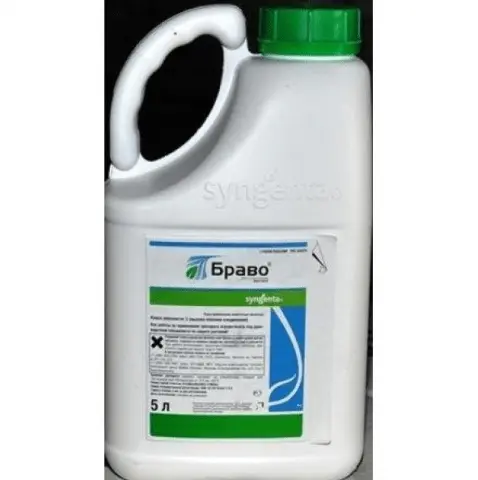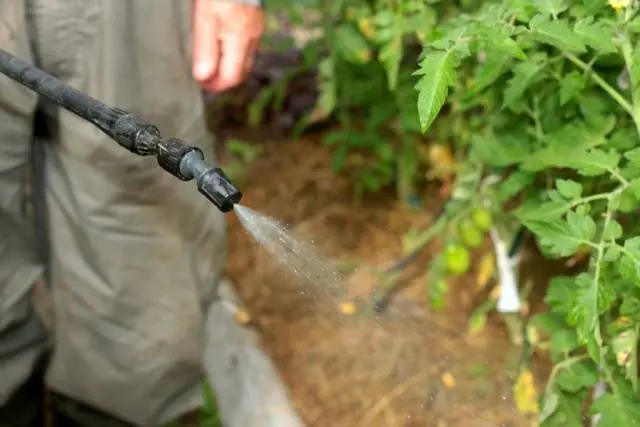Contents
Fungal diseases affect crops, vegetables, vineyards and flower beds. The easiest way to prevent the development of the disease at an early stage. Preventive treatments based on the Bravo preparation protect the surface of plants from the spread of the fungus.
Features of the fungicide
Bravo is a contact fungicide with a protective effect. It contains chlorothalonil, the content of which per 1 liter of the drug is 500 g.
Chlorothalonil is a substance of low toxicity that can cope with various diseases. The substance remains on the surface of the leaves for a long time and prevents the germination of fungal cells. As a result, pathogenic microorganisms lose their ability to penetrate plant tissues.
Within 5-40 days, the active substance decomposes in the soil into safe components. However, in water, chlorothalonil is able to remain in a constant form for a long time.
Bravo is effective against the following diseases:
- downy mildew;
- late blight;
- Alternaria;
- diseases of the ear and leaves of cereal crops.
Fungicide Bravo is supplied in the form of a liquid creamy suspension. The tool is used as a concentrated solution. The protective effect lasts from 7 to 14 days.
The drug is sold in plastic containers with a capacity of 20 ml, 100 ml, 1 l, 5 l and 10 l. The product is compatible with other fungicides and insecticides. Drugs are tested for compatibility before being used in a tank mix.
Advantages
The main advantages of the drug Bravo:
- suitable for grain and vegetable crops;
- used against a wide range of lesions;
- sharing with other protective equipment is allowed;
- retains its effect after heavy watering and rainfall;
- does not cause resistance in pathogens;
- is not phytotoxic for plants at observance of dosages;
- pays off quickly.

Disadvantages
The main disadvantages of Bravo fungicide:
- requires compliance with safety regulations;
- moderately dangerous for insects and warm-blooded organisms;
- is poisonous to fish;
- long remains in reservoirs;
- It is used for the prevention of diseases, with a massive lesion is ineffective.
The order of application
On the basis of the Bravo preparation, a working solution for spraying plants is obtained. The consumption rate is determined depending on the type of crop. According to reviews, the Bravo fungicide is suitable for personal subsidiary plots and farms.
To prepare the solution, containers made of glass or plastic are used. The solution must be used within a day. Landings are processed manually or using specialized equipment.
Wheat
Spring and winter wheat needs protection from powdery mildew, rust and septoria. For spraying plantings, 2,5 liters of Bravo preparation per 1 ha of occupied area are required.
During the season, 2 preventive treatments are enough. The use of Bravo fungicide is allowed in the presence of the first signs of the disease and its moderate development. Spraying is carried out during the growing season. 1 liters of solution are prepared for 300 ha.
Barley
Barley is susceptible to various types of rust (stem, dwarf), powdery mildew and spotting. Spraying with a solution of the Bravo preparation protects plantings from diseases and prevents their spread.
Bravo fungicide solution is prepared in accordance with the instructions for use. For the treatment of 1 ha, 2,5 liters of suspension are required. The liquid consumption for processing the specified area is 300 l.

Potatoes
The most common potato diseases are late blight and early blight. The lesions are fungal in nature. First, the disease in the form of dark spots covers the aerial part of the plants, then it passes to the tubers.
The first processing of potatoes is carried out in the presence of the first symptoms of the disease. During the season, no more than 3 treatments are required. Between procedures maintain a gap of 7-10 days.
According to the instructions for use of the Bravo fungicide, the consumption per 1 ha is 2,5 liters. To process this planting area, 400 liters of the finished solution are needed.
Bow
Onions often suffer from downy mildew. The disease spreads in rainy cold weather. The defeat provokes a fungus that enters the plants with wind and raindrops.
A sign of peronosporosis is the presence of rusty spots on the feathers of the onion. Over time, the feathers turn yellow and adhere to the ground, and the fungus passes to the bulb.
For 1 hectare of plantings, 3 liters of the drug are required. The consumption of the finished solution of the Bravo fungicide according to the instructions is 300-400 liters per 1 ha. During the season, onions are sprayed three times, no more than once every 10 days.
Tomatoes
Tomatoes need protection from late blight and brown spot. These are diseases of a fungal nature that affect leaves, stems and fruits.
To protect tomatoes from diseases, the consumption of Bravo fungicide per 1 ha of plantings is 3 liters. No more than 3 treatments are carried out per season.
The first spraying is carried out when creating favorable conditions for the development of diseases: high humidity, low temperatures, dense plantings. The next treatment starts after 10 days. 1-400 liters of the drug solution are required per 600 ha.

Grapes
Grapes are prone to fungal diseases: oidium, mildew, anthracnose. Lesions appear on the leaves, gradually spread to the entire bush. As a result, yields are lost, and the grapes may die.
To protect plantings from diseases, they practice treating the vineyard with a Bravo fungicide solution. According to the instructions, 10 g of suspension is required for 25 liters of water. In early spring, they start spraying the bushes. 3 weeks before harvesting, the use of the fungicide is completely stopped.
Safety measures
The drug Bravo belongs to the 2nd class of danger for warm-blooded organisms and the 3rd class for bees. The active substance is toxic to fish, so the treatment is carried out at a distance from water bodies.
Upon contact with the skin and mucous membranes, the solution causes irritation. When working with Bravo fungicide, wear long-sleeved clothing and rubber gloves. Respiratory organs are protected with a mask or respirator.
Spraying is carried out in dry weather without strong wind. Permissible speed of movement of air masses – up to 5 m / s.
In case of poisoning, the victim is taken out to fresh air, given several glasses of water and activated charcoal to drink. Be sure to call an ambulance.
The Bravo drug is kept in a dry place, away from animals, children, medicines, food. Shelf life – up to 3 years from the date specified by the manufacturer.

Reviews of gardeners

Conclusion
Bravo is a reliable means of contact action. It is used by farms for the processing of grain and vegetable crops. In the garden plot, the fungicide protects grapes and roses from fungal infections. When working with the drug, precautions are taken. The product is used strictly in accordance with the instructions.









